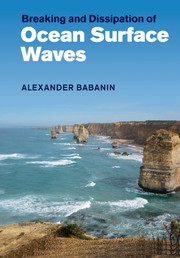Book contents
- Frontmatter
- Contents
- Preface
- 1 Introduction
- 2 Definitions for wave breaking
- 3 Detection and measurement of wave breaking
- 4 Fully nonlinear analytical theories for surface waves and numerical simulations of wave breaking
- 5 Wave-breaking probability
- 6 Wave-breaking severity
- 7 Energy dissipation across the wave spectrum
- 8 Non-dissipative effects of breaking on the wave field
- 9 Role of wave breaking in the air–sea interaction
- 10 Conclusions. What else do we need to know about wave breaking?
- References
- Index
4 - Fully nonlinear analytical theories for surface waves and numerical simulations of wave breaking
Published online by Cambridge University Press: 25 October 2011
- Frontmatter
- Contents
- Preface
- 1 Introduction
- 2 Definitions for wave breaking
- 3 Detection and measurement of wave breaking
- 4 Fully nonlinear analytical theories for surface waves and numerical simulations of wave breaking
- 5 Wave-breaking probability
- 6 Wave-breaking severity
- 7 Energy dissipation across the wave spectrum
- 8 Non-dissipative effects of breaking on the wave field
- 9 Role of wave breaking in the air–sea interaction
- 10 Conclusions. What else do we need to know about wave breaking?
- References
- Index
Summary
The previous chapter was dedicated to experimental methods of detecting wave breaking, quantifying the breaking probability and severity, and measuring effects related to the breaking, including the wave energy dissipation. In the next chapter, it is logical to describe theoretical methods of describing wave-breaking physics or phenomena leading to the breaking.
While experimental oceanography has produced an abundant variety of techniques and approaches to detect and measure breaking, the theories capable of dealing with wave breaking are few. These should not be confused with analytical methods intended to detect the breaking events in surface-wave records (Section 3.7) or with the statistical methods of quantifying the breaking probability and strength (Section 3.8). Both such groups of analytical techniques are placed into experimental Chapter 3 for a good reason – they principally rely on empirical criteria.
Another significant group of analytical approaches, dealing with the dissipation due to breaking, rather than with the breaking as such is also not included in this chapter. Some of these models are based on assumptions intended to interpret pre-breaking or post-breaking properties of the waves, rather than on working with the physics leading to breaking or driving the breaking and its consequences. Others attempt to deduce the dissipation from differences between wave-evolution predictions done by means of kinetic and dynamic equations. In any case, these are indirect techniques that do not depict the wave-breaking event explicitly. They will be described in Section 7.1.
- Type
- Chapter
- Information
- Breaking and Dissipation of Ocean Surface Waves , pp. 118 - 141Publisher: Cambridge University PressPrint publication year: 2011



